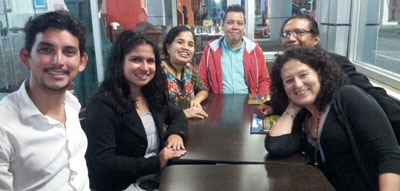Heidi in Panama
When tourists visit Panama, they enjoy the beaches, islands, and mountain forests. ELAW Staff Scientist Heidi Weiskel was in Panama this month with a different agenda.
Heidi used her marine ecologist’s eye to take in what’s threatening Panama’s natural environment. She joined ELAW partners to tour a new highway project that has cut through Panama Bay, the site of a proposed mega-port near Colon, and the site of a gold and copper mine that threatens the Tonosi and Quema Rivers on the Azuero Peninsula.

“The coral reefs and mangroves in the area where ‘Puerto Verde’ is planned are showing very important signs of recovery from oil spills in the 1980s,” says Heidi. “If this ‘green port’ — a miserable misnomer — goes forward, the mangroves will be cut and the seabed, including the reefs, will be dredged. We met with subsistence fishermen and farmers in the area and none of them want the port.”
ELAW is working with partners at El Centro de Incidencia Ambiental (CIAM), Centro de Asistencia Legal Popular Programa para Refugiados, MarViva Panama, and Derechos Humanos, Ambiente y Comunidades to ensure that communities and grassroots advocates have the information they need to make their voices heard and protect Panama for future generations.
In February, we will welcome CIAM Staff Attorney Luisa Arauz for a two-week ELAW Fellowship. Luisa developed an interest in nature and international issues at a young age from her father, a nature guide, and her mother, a diplomat. Luisa will work one-on-one with ELAW staff and participate in the 2014 Public Interest Environmental Law Conference where she will speak about access to information and participation in environmental impact studies of proposed hydroelectric dams and genetically-modified salmon projects.
I will send you updates on Luisa’s visit.
Thank you for your interest!
Sincerely,
Maggie Keenan
ELAW Communications Director & Fellows Program Coordinator

